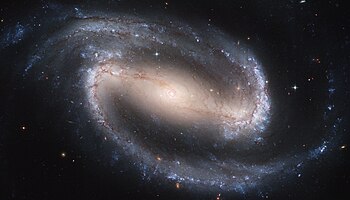We are
bounded in a nutshell of Infinite space: Blog Post #20, Hubble Galactic Tuning Fork: Pick your Galaxy
Starting with elliptical galaxies, which change from most "circular" to most elliptical, we have:
E0:
E1:
E2:
E3:
E4:
E5:
E6:
E7:
And now we move on to Spiral Galaxies, starting with:
S0:
But here, the Spiral Galaxy classification splits off into barred and unbarred spirals. So unbarred Spirals look like:
Sa:
And they continue becoming more complex by adding to their amount of spirals and curvature,
Sb:
Sc:
And now for the barred Spiral Galaxies, which increase in complexity similar to the trend seen in unbarred spirals.
SBa:
SBb:
SBc:
And finally there is a type of galaxy that fits into no classification: the irregular galaxies:
I:
Although there are more galaxies that don't precisely fit into any of these classification, astronomers are starting to understand how galactic formation and evolution accounts for most of the shapes of these galaxies, including the irregular ones. Suffice to say, gas accumulates in a lot of ways, but when gas is the size of thousands of light-years, standard shapes start to emerge.
http://www.newscientist.com/data/galleries/howdoesmygalaxygrow/m87cfht.jpg
http://www2.le.ac.uk/departments/physics/research/xroa/images/m87.gif/image_preview
http://www.astroimages.org/ccd/pics/m32-3.jpg
http://freestarcharts.com/images/Articles/Messier/M86_NASA_AURA_STScI.jpg
http://messier.seds.org/Pics/More/m49noao.jpg
https://www.le.ac.uk/ph/faulkes/web/images/m59.jpg
http://www.astronomynotes.com/galaxy/m110.jpg
http://bama.ua.edu/~rbuta/nearirs0/plate014c.jpg
http://www.mhhe.com/physsci/astronomy/fix/student/images/23f06.jpg
https://www.ualberta.ca/~pogosyan/teaching/ASTRO_122/lect23/ngc2997_aat.gif
http://www.astronomy.ohio-state.edu/~pogge/Ast162/Unit4/Galaxies/aat058.gif
https://upload.wikimedia.org/wikipedia/commons/thumb/c/c5/M101_hires_STScI-PRC2006-10a.jpg/1280px-M101_hires_STScI-PRC2006-10a.jpg
http://skyserver.sdss.org/dr1/en/astro/galaxies/images/n1300_SBb.gif
https://upload.wikimedia.org/wikipedia/commons/thumb/5/52/Hubble2005-01-barred-spiral-galaxy-NGC1300.jpg/350px-Hubble2005-01-barred-spiral-galaxy-NGC1300.jpg
http://www.stardoctor.org/M109-April2007-RubenKier-fullsize.jpg
http://www.robgendlerastropics.com/NGC4449-HST-GendlerS.jpg




Very comprehensive compilation of pictures! I wish you said something about the specific observational characteristics that distinguish between the different classes of galaxies you list, though! And something about the link (or lack of) to their physical natures, too.
ReplyDelete4.5